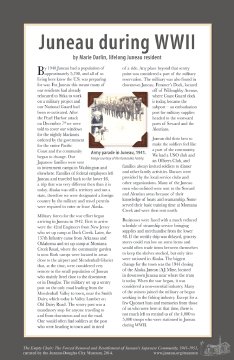|
Description
|
| Juneau during WWII by Marie Darlin, lifelong Juneau resident By 1940 Juneau had a population of approximately 5,700, and all of us living here knew the U.S. was preparing for war. For Juneau this meant many of our residents had already relocated to Sitka to work on a military project and our National Guard had been re-activated. After the Pearl Harbor attack on December 7th we were told to cover our windows for the nightly blackouts ordered by the government for the entire Pacific Coast and the community began to change. Our Japanese families were sent to internment camps in Washington and elsewhere. Families of federal employees left Juneau and traveled back to the lower 48, a trip that was very different then than it is today. Alaska was still a territory and not a state, therefore we were designated a foreign country by the military and travel permits were required to enter or leave Alaska. Military forces for the war effort began arriving in Juneau in 1942. First to arrive were the 42nd Engineers from New Jersey who set up camp at Duck Creek. Later, the 137th Infantry came from Arkansas and Oklahoma and set up camp at Montana Creek Road, where the community garden is now. Both camps were located in areas close to the airport and Mendenhall Glacier that, at the time, were considered very remote to the small population of Juneau who mainly lived close to the downtown or in Douglas. The military set up a sentry post on the only road leading from the Mendenhall Valley to town, near the Smith Dairy, which today is Valley Lumber on Old Dairy Road. The sentry post was a mandatory stop for anyone traveling to and from downtown and out the road. One would often find soldiers at the post who were heading to town and in need of a ride. Any place beyond that sentry point was considered a part of the military reservation. The military was also found in downtown Juneau. Femmer's Dock, located off of Willoughby Avenue, where Coast Guard dock is today, became the subport - an embarkation port for military supplies headed to the westward ports of Seward and the Aleutians. Juneau did their best to make the soldiers feel like a part of the community. We had a USO club and an Officers Club, and families always invited soldiers to dinner and other family activities. Dances were provided by the local service clubs and other organizations. Many of the Juneau men who enlisted were sent to the Seward and Aleutian areas because of their knowledge of boats and seamanship. Some served their basic training time at Montana Creek and were then sent north. Businesses were faced with a much reduced schedule of steamship service bringing supplies and merchandise from the lower 48. If the weekly ship was delayed, grocery stores could run low on some items and would often trade items between themselves to keep the shelves stocked, but only tires were rationed in Alaska. The biggest change for the town was the 1944 closing of the Alaska Juneau (AJ) Mine, located in downtown Juneau near where the tram is today. When the war began, it was considered a non-essential industry. Many of the miners joined the military or began working in the fishing industry. Except for a few Quonset huts and memories from those of us who were here at that time, there is not much left to remind us of the 4,000 to 5,000 troops who were stationed in Juneau during WWII. Image Caption: Army parade in Juneau, 1941. Image courtesy of the Kumasaka Family. |
Juneau During WWII Panel
-The Empty Chair: The Forced Removal and Relocation of Juneau's Japanese, 1941-1951
-Permission to use this image may be obtained by contacting museum staff.

All images are the property of the Juneau-Douglas City Museum. No image may be copied, downloaded or reproduced without the express permission of the Juneau-Douglas City Museum.

All images are the property of the Juneau-Douglas City Museum. No image may be copied, downloaded or reproduced without the express permission of the Juneau-Douglas City Museum.